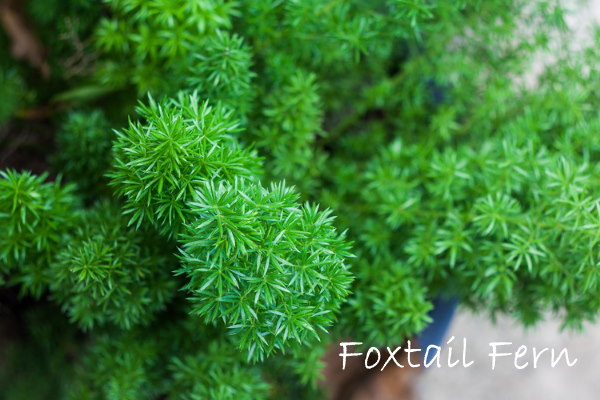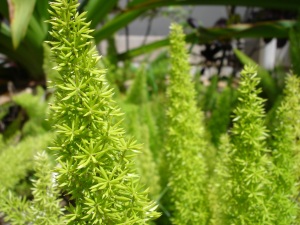Care of Foxtail Fern
Botanical Name: Asparagus densiflorus 'Myers'
Upright, emerald plumes make foxtail fern a gorgeous accent plant for container groupings or staging among tropicals.
 Light, airy plumes make Asparagus Fern a captivating houseplant. Photo © Hadkhanong
Light, airy plumes make Asparagus Fern a captivating houseplant. Photo © HadkhanongGet to Know Foxtail Fern
This beautiful house plant is easy to grow and some say more decorative than its close relative, the asparagus fern. Foxtail fern is not a true fern, but a member of the lily family. Although there is no family resemblance, it's also related to the edible asparagus vegetable.
Stems are densely covered with 1 in (2.5 cm) needle-like leaflets give this plant a delicate, feathery appearance. But don't let its fragile appearance fool you. In its native, warm temperature forests of Africa, foxtail fern is an aggressive grower and can be invasive. That's not a problem, though, contained in a pot. Cut the stems back or divide the plant in spring to keep it under control.
Growing Foxtail Fern Year-Round
Prune it back. Cut back stems to keep this fern compact and bushy. Trim off old, faded fronds to make room for new growth and to keep the plant looking its best.
Repot in spring. Move to a pot only 1-2 in (2.5-5 cm) larger. Allow at least 1 in (2.5 cm) space from the rim of the pot, because the fleshy, tuberous roots sometimes force the potting mix up as they grow.
Leaf drop is usually a symptom of too little or too much sunlight -- or, more likely -- dry soil. Foxtail likes dappled sunlight. Water regularly, but take care not to overwater. The plant's thick, tuberous roots store water and soggy soil can cause root rot. Raising the humidity can help; this plant loves to be misted.
Something bugging your plant? Dry conditions in winter may draw spider mites to houseplants. They're so tiny, they are hardly noticeable. You'll recognize them by the fine webbing among the foliage. Raising the humidity around your tropical plants will help to prevent them. Treat any infestation immediately because spider mites multiply quickly, then will move on to your other houseplants.
Foxtail Fern Care Tips
 Feathery plumes make Foxtail a beauty.
Feathery plumes make Foxtail a beauty.Origin: South Africa
Height: Up to 3 ft (90 cm) long
Light: Bright indirect sunlight year-round. For even growth, give the plant a quarter turn every week or so to expose all sides to sunlight.
Water: Water thoroughly, allowing soil to dry out a little between waterings. Too much water can lead to root rot. Water sparingly in winter, but do not allow soil to dry out completely, which can cause foxtail fern to shed its leaflets. Remember to use tepid water to water your house plants.
Humidity: Prefers moist air. Aim to maintain 40-50% relative humidity. Set pot on a tray of wet pebbles and mist leaves with room-temperature water. Indoor air can become extremely dry in winter; use a cool-mist room humidifier near your plant, if needed.
Temperature: Average room temperatures 65-75°F/18-24°C. Foxtail fern will tolerate a minimum of 50°F/10°C. Keep this plant away from heat/AC vents.
Soil: All-purpose, good-quality potting mix
Fertilizer: Feed monthly spring through fall with a balanced (such as 10-10-10 NPK) water-soluble houseplant fertilizer.
Propagation: Division. Divide overcrowded plants in spring. Remove the plant from its pot and cut through the thick roots with a sharp knife to avoid pulling and tearing them. Try to keep as much of the roots intact as possible.


